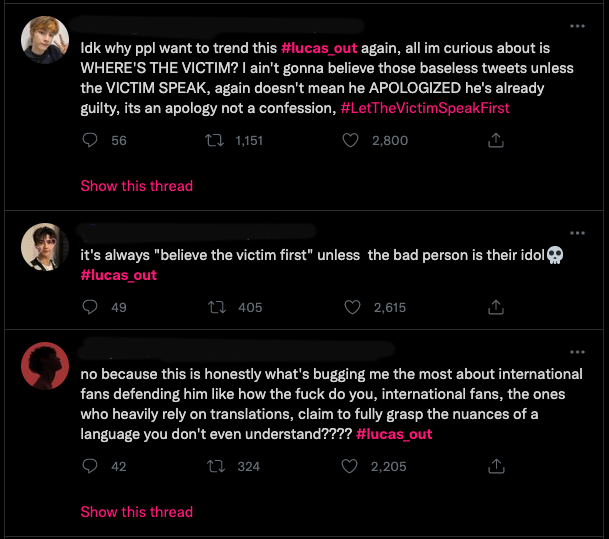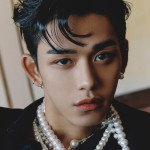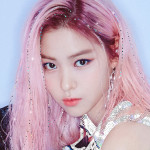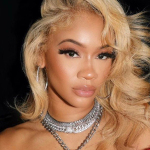In today's social media age, we see trends happen every day. Every so often, a celebrity would trend on social media platforms over behavior considered offensive or socially unacceptable. From politics to Hollywood, all kinds of public figures have been called out for such behavior by the masses. This form of modern ostracism is known as “cancel culture”, where the public attempt to call out and boycott an individual in response to something problematic they've said or done. In particular, the music industry is no stranger to cancel culture as countless musicians such as Travis Scott or Lana Del Rey have trended in the past over controversies.
The rise of cancel culture has given power to people on social media platforms like Twitter, where they can hold musicians publicly accountable for their actions through spreading hashtags and trends. From people calling out Nicki Minaj for spreading COVID-19 vaccine misinformation to K-Pop stans asking for WayV's Lucas to leave the group through hashtag #LUCAS_OUT, it is not a surprise for people to react with outrage and toxicity towards musicians on Twitter after their controversies.

Example of How Users Reacted to Lucas' Controversy By Using #LUCAS_OUT
This made us wonder: among English-speaking Twitter users, how does their sentiment towards canceled musicians change over time? To answer this question, we analyzed how public sentiment was affected by the type of issue the musician was canceled for, the background of the musician, and the strength of the musician's parasocial relationship with their fans.
Our Hypothesis
Online cancel culture on Twitter can lead to an overall increase in toxicity and negative sentiment towards a canceled musician, notably after their controversy.
The Data
For our analysis, we focused on three different genres of music: K-pop, hip-hop, and pop. We then selected two canceled artists, one male and one female, and two artists who have not been canceled, also one male and one female, to act as our controls.
Introducing the Artists...
Hover over a canceled artist for details on why they got canceled.
K-Pop
Cancelled Artists

Lucas
Group: NCT/WayV
Follower Count: 2M
Date Cancelled: 8/24/21
Reason for Cancellation:
Emotional Abuse Allegations

Giselle
Group: Aespa
Follower Count: 2.2M
Date Cancelled: 10/23/21
Reason for Cancellation:
Lipsyncing the N word
Control Artists

Jaemin
Group: NCT/NCT Dream
Follower Count: 6.9M

Ryujin
Group: ITZY
Follower Count: 4.5M
Hip-Hop
Cancelled Artists

DaBaby
Follower Count: 4.4M
Date Cancelled: 7/28/21
Reason for Cancellation:
Homophobic Remarks

Nicki Minaj
Follower Count: 24M
Date Cancelled: 9/13/21
Reason for Cancellation:
COVID-19 Misinformation
Control Artists

Lil Baby
Follower Count: 6.2M

Saweetie
Follower Count: 2M
Pop
Cancelled Artists

Zayn Malik
Follower Count: 31M
Date Cancelled: 10/28/21
Reason for Cancellation:
Physical Abuse Allegations

Doja Cat
Follower Count: 4.5M
Date Cancelled: 5/25/20
Reason for Cancellation:
Racism Allegations
Control Artists

Harry Styles
Follower Count: 37.4M

Adele
Follower Count: 27.2M
We collected tweets on these artists using the Twitter API, where we searched for tweets containing hashtags and keywords relating to the artist's cancellation, name, and fanbase.
Cancelled Artists Dataset Overview
| Artist | Initial # of Tweets | Hashtags & Keywords Used for Query |
|---|---|---|
| Lucas | 110,000+ | "lucas", “bubble”,“bbl”, “scandal", "xuxi", "yukhei", "nct","czennie", "czennies", "nctzen", "lumis", "weishennie", "nctzens", "weishennies", "wayv", "weishenv", "ot23", "ot22", "ot6", "ot7", "#NCT", "#LUCAS", "#WayV", "WeiShenV", "#WELOVEYOULUCAS", "#LUCAS_OUT", "#WAYV_is_7", "#LUCASBESTBOY", "#WayVis7", "#LUCAS_GETS_OUT_OF_NCT", "#LUCAS_GETS_OUT_OF_WayV" |
| Giselle | 35,000+ | "giselle", "uchinaga", "kpop", "k-pop", "bbl", "bubble”, "MYs", "MY", "aeri", "n word", "racist", "aespa", "#aespa", "#gisellenword", "giselleaespa", "#Giselle_OUT", "#gisellenwordspace", "#giselleapologize", "#aespa_is_FOUR" |
| Dababy | 100,000+ | "dababy", #DaBabyisOverParty, #DaBookings, #DaApology, #Dababy |
| Nicki Minaj | 90,000+ | "nicki minaj, #NickiMinaj, #Nicki, #MyCousinTookTheVaccine, #NickiMinajsCousinsFriendsBalls, #NickisCousinsFriendsBalls, #nickiminajdraggingparty, #iStandWithNicki, #istandwithnickiminaj, #barbz, barbz |
| Zayn Malik | 50,000+ | “zayn malik”, “zayn”, “zayn hits yolanda”, “zayn and gigi”, “zayn malik and gigi hadid”, “zayn cheated”, #WeAreWithZayn, #ZaynMalik, #FreeZayn, #welovezayn, #AlwaysWithYouZayn, #respectzayn, #WeSupportZayn, #cancelzayn, #WeHateZayn |
| Doja Cat | 380,000+ | “doja cat”, “doja”, “dindu nuffin song”, #dojawasinnocent, #dojacatisNOToverparty, “WeAreSorryDoja”, #dojacatisoverparty, #DojaIsOverParty, #DojaCat |
Control Artists Dataset Overview
| Artist | Initial # of Tweets | Hashtags & Keywords Used for Query |
|---|---|---|
| Jaemin | 120,000+ | "na jaemin", "jaemin", “bbl”, “bubble”, “nct”, “nct dream”, “nana”, “nctzens”, "czennie", "czennies", "nctzen", “#NCT”, “#NCTDREAM” |
| Ryujin | 110,000+ | "ryujin", "shin", "itzy", "#ITZY", "midzy", "midzys", "#RYUJIN" |
| Lil Baby | 140,000+ | “lil baby”, “#lilbaby” |
| Saweetie | 70,000+ | '"saweetie" , “#saweetie” |
| Harry Styles | 430,000+ | “harry styles”, “harry”, “styles”, #harry, #harrystyles |
| Adele | 34,000+ | “adele”, #adele, #adele25, #adele21, #adelelove |
Methods
To measure sentiment, we utilized sentiment analysis, which is a natural language processing technique that quantifies emotions within in a piece of text. Because we're interested in seeing if there is a change in negative sentiment over time, we calculated two metrics, severe toxicity and insult probability scores, on our tweet data. Tweets that are percieved as highly toxicity are given higher severe toxicity and insult scores.
Positive Example: Today is a nice day :)
Severe Toxicity Score: 0.02
Insult Score: 0.02
Negative Example: I really HATE this song SO BAD
Severe Toxicity Score: 0.35
Insult Score: 0.44
Type of Issue For Cancellation
The case studies we present overlap in the type of issue they were “canceled” for. For example, both Lucas and Zayn Malik faced backlash for abuse related conflicts. Lucas was canceled for emotional abuse allegations and Zayn was accused of physical assault. Another category is discrimation against a marginalized group. Three of our case studies fall into this category: Giselle, Doja Cat, and Dababy. Giselle and Doja Cat both received harsh criticism for singing racial slurs known to be used to degrade the African American community. Similarly, Dababy made homophobic remarks, which disrespected the LGBTQ+ community. The final category is misinformation, which includes Nicki Minaj’s controversy for COVID-19 vaccine misinformation. Given the current socio-political environment, we believe that the issue an individual was canceled for could influence the severity of negative sentiment towards them.
To test this, we conducted two types of analysis: qualitative and quantitative. For our qualitative analysis, we compared words with the highest frequencies before and after the controversy. Based on this, we were able to determine which category promoted more dialogue surrounding the conflict. For the quantitative analysis, we compared severe toxicity and insult levels before and after cancellation for each category.
Canceled Artists By Type of Issue
Hover over a canceled artist to see their genre and issue.
Discrimination Against Marginalized Groups

GISELLE
Genre: K-PopReason: Lipsyncing Racial Slur

DABABY
Genre: Hip-HopReason: Homophobic Remarks

DOJA CAT
Genre: PopReason: Racism Allegations
Abuse Allegations

LUCAS
Genre: K-PopReason: Emotional Abuse Allegations

ZAYN MALIK
Genre: PopReason: Physical Abuse Allegations
Misinformation

NICKI MINAJ
Genre: Hip-HopReason: COVID-19 Misinformation
Background of Canceled Artist
Outside of just being in the music industry, our chosen individuals have a lot of similarities in their background as well as distinct differences. We believe these differences may influence the severity of negative sentiment, as well as the duration of that negative sentiment after getting canceled.
In order to determine whether or not the background of an artist has an effect on the sentiment they receive after being canceled, we separated our artists into two different groups. Our first group is based on the genre of music they make, which are K-pop, Hip-Hop, and Pop. The second group of artists is based on their sex, so comparing female artists and male artists. The metric we used to compare artists in these groupings is determined by how many days after cancellation it takes for their median sentiment levels to return to its pre-controversy levels.
Strength of Parasocial Relationships
Parasocial relationships are one-sided relationships in which an individual develops an illusion of an intimate connection with a media personality, as a result of repeated interactions between them. For example, a fan who has followed an artist for a period of time and has learnt enough about them to develop a sense of loyalty might feel that they have a personal connection with the artist. Depending on the strength of the relationship, media personalities can have a strong influence over their audiences as evident with fandoms like BTS’s ARMYs or Taylor Swift’s Swifties.
To determine which artists have either a strong or weak parasocial relationship with their fanbase, we used the following two metrics: the artist's total mean tweet engagement and the amount of tweets mentioning their fandom. Based on those metrics, we then grouped our artists into two groups: artists with strong or weak parasocial relationship with their fans. We then compared the change in average severe toxicity and insult scores over time in respect to each group.
Fandom Names By Artist and Parasocial Strength
Select a Genre
Strong Parasocial Relationship

LUCAS
weishennies; NCTzens;
lumis; czeenies

GISELLE
MYs; aerishines

NICKI
MINAJ
barbz
Weak Parasocial Relationship

ZAYN
MALIK
directioners; zquad

DOJA CAT
kittenz

DABABY
no fandom name(s)
Results
Type of Issue For Cancellation
Our comparison of word frequencies shows that the discrimination towards a marginalized group (specifically the African American community) category promotes more conversation surrounding the controversy in comparison to the abuse and misinformation categories. This is evident as the “Most Common Words After Cancellation For Discrimination Issue Group” chart presents “black” as the 7th most frequent word and also "racist" within the top 50, whereas both the abuse and misinformation graphs did not display any words related to the conflict in question.
When looking at how the subject of the controversy affects sentiment, our artists who are canceled for discrimination against a marginalized group tend to promote higher negative sentiment compared to our artists with issues relating to abuse and misinformation. All groups have an initial spike immediately after their controversy. However, the discrimation category has a slightly larger spike in severe toxicity and two more spikes are seen around the 40 and 90 day mark. Moreover, this category has the highest average severe toxicity level after their respective incidents occurred. The trend is not as distinct when comparing insult levels, however, it does provide a similar result.
Change in Median Severe Toxicity Score By Type of Issue
Change in Median Insult Score By Type of Issue
Although misinformation and discrimation follow a similar trend in insult levels post controversy, discrimation exhibits the largest spike and displays a slight increase in negative sentiment as another spike is recognized around the 100 day mark. Based on this, artists who are canceled for being discriminatory appear to get the most backlash.
Background of Canceled Artist
Comparing different genres to each other, hip-hop stands out. For both severe toxicity and insult score levels, hip-hop artists’ sentiment levels took the longest to return back to normal or pre-controversy levels compared to K-pop and pop artists. The results based on sex show that canceled male artists experience a much longer effect from canceling. In terms of duration, canceled male artists experience a rise in severe toxicity for more than three times longer than female artists. For median insult levels, the rise in insult levels is more than four times longer for canceled male artists compared to female artists.
Duration of Severe Toxicity By Genre
| K-Pop | Hip-Hop | Pop | |
|---|---|---|---|
| # Days to Return to Pre-Controversy Levels |
26 | 35 | 18 |
| Day 0 Median Level | 0.15 | 0.17 | 0.22 |
Duration of Insults By Genre
| K-Pop | Hip-Hop | Pop | |
|---|---|---|---|
| # Days to Return to Pre-Controversy Levels |
18 | 30 | 1 |
| Day 0 Median Level | 0.12 | 0.14 | 0.18 |
Duration of Severe Toxicity By Sex
| Male | Female | |
|---|---|---|
| # Days to Return to Pre-Controversy Levels |
71 | 18 |
| Day 0 Median Level | 0.11 | 0.19 |
Duration of Insults By Sex
| Male | Female | |
|---|---|---|
| # Days to Return to Pre-Controversy Levels |
71 | 13 |
| Day 0 Median Level | 0.13 | 0.24 |
Change in Median Severe Toxicity Score By Genre
Change in Median Insult Score By Genre
Change in Median Severe Toxcity Score By Sex
Change in Median Insult Score By Sex
The plots comparing genres show that hip-hop artists experience the most drastic change in toxic sentiment based on severe toxicity and insults.
The median negative sentiment for hip-hop artists seems to be the lowest
compared to K-pop and pop before controversy, but it rises to the highest median levels out of the three genres
immediately after controversy.
When comparing sex, female artists experience a more drastic rise in severe toxicity and insults after their controversies.
Female artists also have greater median severe toxicity and insult levels before and after cancellation compared to canceled male artists.
Combining our results for sex,
male artists tend to endure a longer rise in negative sentiment after being canceled while
female artists seem to experience a more intense negative response for a
much shorter period of time after cancellation.
Strength of Parasocial Relationships
Looking at how sentiment is affected by the strength of an artist's parasocial relationship with their fans, artists with a strong parasocial relationship tend to have lower negative sentiment overall compared to artists with a weak parasocial relationship. Both groups see a significant increase in severe toxicity and insults a few days after cancellation and also experience a spike after 100 days, most likely due to the controversy resurfacing. However, the weak parasocial group experiences a more severe increase in toxicity that's similar to its spike directly after cancellation.
Change in Median Severe Toxicity Score
By Parasocial Strength
Change in Median Insult Score
By Parasocial Strength
By having a strong parasocial connection with the artist, these artists' fanbases are more likely to defend the artist and block as much negativity surrounding them and their controversies as possible. This is a possible explanation for the difference we see in overall negative sentiment between our strong and weak parasocial groups. Therefore, artists with a strong parasocial relationship with their fans seem to be more protected against the effects of Twitter cancel culture.
Conclusion
Through our research, we’ve determined that various factors concerning the artists can have an effect on the duration and severity of negative sentiment towards them after cancellation. For different types of controversies, being canceled for discrimination against marginalized groups tended to get greater backlash compared to others. For the background of the artists, hip hop artists stood out with the most severe response after being canceled. For parasocial relationships, artists with a strong parasocial relationship with their fans appeared to have lower overall negative sentiment.
Overall, among English-speaking users, Twitter cancel culture can lead to a negative effect on sentiment over time towards music artists. Sentiment surrounding our case studies on Twitter, measured through severe toxicity and insult score levels, indicated there appears to be a rise in toxicity and negativity towards them after being canceled. However, long term effects, such as complete ostracization from mainstream popular culture or prolonged sustained toxicity, didn’t seem to occur as eventually sentiment returned to normal for all of our artists within 6 months after cancellation.
Cancel culture on Twitter and social media in general is still an evolving phenomenon that has only begun to gain attention in recent years. However, we believe that our research has at least provided some context to understand and quantify cancel culture as a whole.